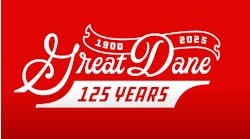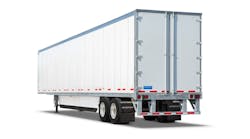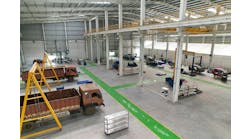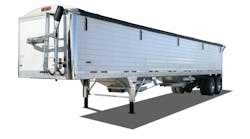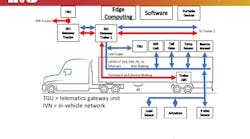Editor's note: This is part one of a two-part series on smart-trailer technology. Read part two.
Fleets aren’t interested in technology for technology’s sake. If that technology can’t be used to benefit a carrier's immediate needs or to cost-effectively improve operations, what good is it? And, based on a wide-ranging discussion among fleet leaders at the recent Truck Trailer Manufacturers Association annual convention, trailer telematics is an area where technology providers just need to focus on delivering the information that keeps the wheels turning—with a solution that is simple, reliable, and doesn’t require another data subscription.
As for the role of trailer manufacturers, panelists representing a variety of fleets and applications were unanimous: Come up with a standard and maintainable platform for telematics providers to build on, because “it's a Wild West show out there.”
But maybe there's more to "smart trailers" than meets this quarter's profit and loss. So what sort of trailer telematics systems should you consider for your fleet? As with every other aspect of managing commercial vehicles, it depends: on markets, on equipment, on customers.
Fleet perspectives
J.B. Hunt Transport Services sits near the top of the trailing-equipment pyramid, utilizing about 100,000 containers that have tracking “of some sort” and another 30,000 to 50,000 trailers, a “good portion” of which have trailer tracking as well, reported Tommy Cottingham, director of maintenance and equipment procurement.
“Trailer tracking continues to be a very hot topic within our organization. For instance, two years ago, I couldn't tell you what IoT stood for; now we're very accustomed to what that means,” Cottingham said. “We're constantly exploring telematics. We're currently looking at high fidelity track and trace of the product because our customers are starting to demand options that companies like Lyft, Uber, and Amazon are providing to their customers.
“We're also looking at other technology that can keep our trailers secured as we start to explore options where J.B. Hunt, oftentimes, is not hauling our own trailers; many other carriers are pulling our equipment. So we need a way to make sure that the right person is pulling the right trailer—not only in our fleet but also others.”
Despite all of the high-tech bells and whistles in the telematics marketplace, however, Cottingham still hasn't found exactly what he’s looking for.
“The options that are currently available just don't meet our needs when you start talking about other sensors: tire inflation and brake wear, etc.,” he said. “There are too many options and not enough standardization.”
On the other hand, Premier Trailer Leasing buys telematics systems for its trailer fleet, but most customers don’t utilize the data. The company has around 50,000 trailers, and 45,000 have tracking, explained CEO Jim Aubuchon. While about half of Premier’s customers use the available trailer tracking through the telematics portal, only one in five integrates the telematics into their TMS. Aubuchon’s current challenge? Replacing 15,000 3G network units.
“I think you're looking at a new network every four to five years, so you're going to replace devices about every four to five years,” he said, and he wasn't enthusiastic about the prospect. “Sure, I think that all these things are cool, but unless you can get actionable data to somebody, they're not going to use it and they're not going to pay for it."
Smaller, more specialized fleets have different needs.
Flatbed carrier Maverick Transportation runs about 1,600 power units and 2,400 open-air or platform trailers, so Mike Jeffress, vice president of maintenance, doesn’t need “really sophisticated stuff” like GPS load tracking or real-time ETA reporting from the trailer. That data comes from the tractor’s telematics system.
“We're looking, initially, at basics: brake wear, inflation pressures—that kind of thing. And then trying to standardize those: How do we communicate all of that through the telematics systems that we already have?” Jeffress said. “Or if we're looking at going down the path of a new telematics provider, then subsequently we're dragging in the other departments within our organization because we need a unified direction. The subscription-based business models that are out there are really, really challenging and daunting to us from that perspective. The providers need to have all of those offerings available, not piecemeal items.”
But the condition of the load is everything for similarly sized K&B Transport, which runs about 1,600 refrigerated trailers to haul fresh meat out of Iowa. K&B recently transitioned the fleet to Carrier Transicold’s eSolutions system to “standardize” around one refrigeration unit and one telematics platform.
“On-time and on-temperature delivery is paramount to what we do—it's all we have to sell,” said K&B Vice President Brock Ackerman. “So we use telematics for a hybrid of both maintenance and operations. We would really like to have some kind of common platform on a trailer so that we don't have to monitor several different internet portals to gather the information that we need—both for our internal operations and then what our customers need. They want to know exactly what the refrigeration unit was doing from the time of departure from their plant all the way to the arrival at a distribution center.”
And, perhaps most specialized of all, Kenan Advantage Group operates about 11,000 tanker trailers—very expensive equipment that can stay in service two to three times longer than common trailers. Still, Kirk Altrichter, vice president of fleet services, pointed to many of the same issues as did others on the panel, particularly items that are subject to roadside inspections (and the company’s CSA score).
“Tires, lights, brakes, basic things—I don't need to run before I can walk,” Altrichter said. “I don't necessarily appreciate everything going into the back office; that's information overload. I'm not saying we don't want it, but I would rather inform the driver who's in the truck pulling the trailer.”
Among the unique challenges faced by tanker fleets, Altrichter cited the need to run wiring on the side of the trailer where it is more exposed than on vans or flatbeds where the lines run along the trailer frame rails.
“As I look at the capabilities and as we move toward utilizing more of the features and tying it all in, we've got to focus on the little things,” he said. “That wiring harness that's exposed either needs a different coating or needs to be run in something different so that it doesn't wear out in a short period of time.”
And Premier’s Aubuchon wants today’s harnesses to have the capability to deliver tomorrow’s data loads.
“We need a standardized harness to capture all this information, even if you’ve got to pay 200 more dollars for the harness to have that capability, so you don't have to rewire the trailer in the future,” he said. “I do think there's a lot of value in that.”
Harness hardware
A recent Endeavor CV Tech Quick Chat, “Evolution of the Smart Trailer, Wiring System, Wiring Harness,” addressed those fleet concerns directly with supplier Peterson Manufacturing. “Corrosion is definitely the biggest problem when it comes to trailer lighting and communication,” Jeff Geoffroy, Peterson's director of business development, said.
So fleets need to look for wiring that prevents moisture from entering the electrical system or, in turn, for modular solutions that simplify repair by limiting that damage to replaceable sections, Geoffroy explained.
Connectors have improved with the evolution from PL-3 to PL-10 to AMP standards, he noted, and Peterson harnesses now feature a proprietary “integrated moisture barrier” to prevent the spread of harmful moisture beyond the damaged area of the cable. LED lamps also are much less likely to fail than incandescent bulbs. Likewise, the Peterson Defender Modular Harness System has numerous layers of protection against moisture and comes with a 10-year guarantee against corrosion.
But basic wiring is just an element in a CAN bus communication system.
“A CAN bus dramatically eliminates the amount of wires that are needed in the harness, because they can all share the same network,” Geoffroy said. “It lets a lot of sensors and devices talk to each other without requiring point-to-point wiring between each—they share that network.”
And with networks comes the issue of open versus closed systems.
“So with an open architecture, you get to choose the products that are best for your situation; you're not limited to one brand,” Geoffroy said. “The disadvantage to the closed system is you have to buy from one brand; but on the positive side, you don't have finger-pointing between the products [if there’s a problem]. Again, there's pros and cons to both.”
In defining smart trailers, Geoffroy essentially summarized the wish list of the fleet telematics panel: to monitor the real-time status of vital trailer systems, and alert drivers and fleet managers to new and developing situations.
Peterson’s smart trailer solution, the Peterson Pulse, specifically addresses the three “big buckets of value” for assessing ROI, he continued.
“Improving the customer experience is the first one, by delivering loads on time and making sure that they're secure and nothing has been lost or damaged,” Geoffroy said. “Reducing downtime and maintenance costs is another category, by catching issues early before they turn into big expensive problems. As everyone knows, maintenance time in your shop is a lot less expensive than the maintenance on the side of a road, not to mention the potentially late delivery. The third bucket is about ensuring that all your systems are active and working right.”
The sensor array is where the actionable data originates: GPS, cargo temperature, open door, ABS, TPMS, lights.
“With Peterson Pulse, all these sensors are sharing data over the network, and that data is being transmitted to the driver via Bluetooth or to the fleet manager via cellular,” he said. “So that's really what the smart trailers do to add the value to the fleet—and why they should take a look if they have interest in those three areas.”
Any fleet wanting to evaluate smart-trailer technology needs two things, according to Geoffroy: a “definition of success” and the resources to see the test through.
“Fleets and suppliers need to develop a plan before they start a trial with a smart trailer—or any new technology,” he said. “What problems are you trying to solve first? What KPIs are you going to use? How much time or how many miles are required to get that data for accurate KPI measurements?”
Defining the problem allows the fleet to focus on what’s important and gives the supplier a better idea of whether theirs is the right solution. Additionally, both the fleet and the supplier need someone to be “in charge,” to manage the test and evaluate the data—ideally an “executive sponsor” on the fleet side and a VP of sales from the supplier, he suggested.
Some test programs may need a year of data, or 100,000 miles, Geoffroy noted—and decision-makers have to be disciplined enough to stay with the targets and not to abandon the test prematurely.
“In the end, if you don't have your definition of success and resources, you shouldn't even start to trial,” he concluded, “because it's just going to consume a lot of energy and resources without solving any problems.”
Indeed, testing is critical—and also can be a resource challenge. Several TTMA fleet panelists recalled recent cases of trying out products that were more trouble than they were worth.
“We put five sets of TPMS out there, and every week on average I was getting 50 messages,” Kenan’s Altrichter said. “So the problem is still all the bugs haven’t been worked out. And 50 messages on five trailers in one week, multiply that times 11,000 and you understand some of the dilemma that we face.”
A recent telematics test for J.B. Hunt triggered so many false alerts that it became “disruptive” to an account, Cottingham added. And troubleshooting became its own problem.
“A lot of us are relying on third-party maintenance facilities to make repairs to these systems, and when it comes to this high-tech stuff, it just doesn't get fixed,” Cottingham said. “You end up with something that doesn't even work. So, depending on where the system failed, our road service crew is now trying to educate the vendor on how to fix the system to get the trailer limped home.”
